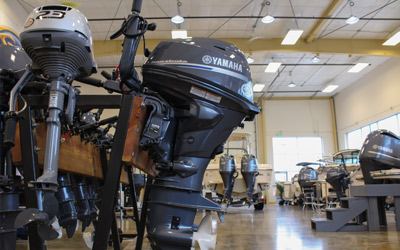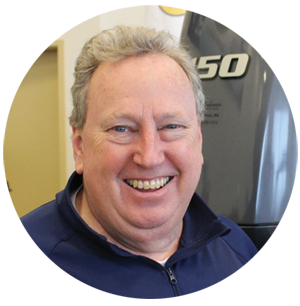“Life is 440 horsepower in a 2-cylinder engine.”
—Henry Miller
Other than the boat hull itself, and rigging when applicable, the motor is the biggest factor in a how a boat performs. Outboard motors are traditionally seen on smaller craft, but with their versatility and convenience, the outboard motor has become more favored among manufacturers of larger boats. This increased popularity has inspired us to dive into outboards and get the info you need for your next motor purchase.
The motor you choose can make or break your boating experience, so you need to know what you’re looking for. There’s an outboard that’s best for trolling around in a dinghy at 3 knots, another for spending a few days offshore fishing, a different one for opening the throttle to make some waves, and everything in between. Outboards come in different strokes, a range of horse powers, various weights, and utilize different fuel sources. The perfect motor for your craft might not even be close to what someone else needs to get the job done; the battle is finding the perfect Goldilocks fit for your craft.
And that’s just the beginning, for outboard owners should know how to clean the motor, how to store it, and what fuel is best. We decided to sit down with Terry McCartney and Tom Ross of Jacobsen’s Marine, an outboard motor dealer in Edmonds, Washington, and asked them about all things outboard motors.
Q: What advice would you give a brand new boater on what outboard to purchase?
Terry: Well, the place to start would be to figure out what you want to do, what type of boating you see yourself doing, and if it’s a boat you’re going to cruise with. Once you’ve established your needs with a boat, that dictates your needs in an engine. To have an adequate performing boat, depending on its size and weight, will determine how big a motor you need.
Tom: We have a lot of entry level guys that come through, and it’s good to keep it simple. You don’t want to overwhelm them with a big boat, especially if they’re going into boating for the first time. Think 19-footer, single-axel trailer, single engine, reliable. The 19’ Grady White is probably one of our most popular entry-level boats.
Q: What are some advantages of an outboard over an inboard motor?
Terry: Winterization is not as big of a factor with outboards. With outboard motors, there’s no need to drain them and they’re less complicated than inboards, so they’re less costly to own.
You mentioned inboards, well there’s straight inboards which have the shaft and the rudder and fixed strut, that’s big boats usually 36′ and above. Inboard/outboards are common 34′ and below, where you have an automotive engine that’s been converted to marine, and then the PTO (power take off) is in a horizontal plane. It’s gotta go down, and then it’s gotta go to the propeller, so you have two transmissions. That way involves a lot more through-hulls with U-joints and gimble bearings, bellows, more vulnerable moving parts, and because the engine was an automotive engine that’s been converted, the life expectancy has been diminished. It’s not uncommon to see a ten-year-old stern drive boat on its second engine. It’s also nice not to have to worry about a through-hull with outboards.
Founder Bob Jacobsen started Jacobsen’s Marine in 1951, originally in the Ballard district of Seattle, Washington. A consummate boater, Jacobsen was an avid outboard racer. Bob eventually sold the business to his son Greg Jacobsen and business partner Terry McCartney, who have kept the tradition of outboard excellence alive and well in the current Edmonds, Washington, location.
jacobsensmarine.com // 206-789-7474

Tom: For safety, no through-hulls is great. I remember once a real nice 28’ boat across the way was nose up, half-sunk in the water. They suspected that one of the through-hull fittings or a bellows leaked and caused it to take on water, sunk it, through no fault of the owner, just happenstance.
Outboard boats can be built as unsinkable boats. Grady White is an example. That company builds boats for people who want to fish offshore. They’re strictly outboard boats, and the thing that really pushed them into that (outboard motors) is a guy fishing 50 miles out into the ocean finds some comfort knowing that he’s in an unsinkable boat. If it’s a case where they can fill the boat with foam and make it self-bailing, you can’t put enough water in it to cause it to go under.
An inboard has a big hole in the floor where the engine sits down below the waterline. If you swamp the cockpit, it fills the engine room with water. Now you have a big cast iron anchor in the back that pulls the boat under.
Also, there’s no ignition source down in the bilge with outboards. With inboard/outboards, you have to run a fan for four or five minutes before you try and start it just to evacuate any fumes from below deck. With an outboard boat, there’s nothing in the bilge that could spark or blow it up.
Q: Outboards come in both a pull-start and an electric-start. What are the pros and cons of each?
Terry: Well the electric-start has to have a battery. If it’s a portable boat, and you don’t want a 30-lb. battery to deal with, you’re going to limit yourself to a pull-start motor.
Tom: There are specific guys that want that pull-start, like a sailor, to keep down the weight. You just want something simple, like a six-horse power, pull-start with internal gas tank. Everything is contained. If you don’t want it aboard, you can take it off. Maybe an owner of a larger boat just wants a backup motor. A true redundancy back-up has a pull start because there’s no electrical going to it. You can start it whenever, long as you’ve got fuel.
Q: What are the pros and cons of short shaft outboards vs. long shaft outboards?
Terry: Well the propellers are always the same distance below the bottom of the boat. In the event of a long shaft, that just means they’ve built the back of the boat up higher, and they’ve put a long shaft motor on. The propeller stays in the same place when the motor is mounted, but the transom is raised up 5” from a short shaft situation.
 Terry McCartney has been around boats since his childhood and got his start on the water playing around with and working on his own boats as a kid. He learned through necessity how to take care of a boat and motor.
Terry McCartney has been around boats since his childhood and got his start on the water playing around with and working on his own boats as a kid. He learned through necessity how to take care of a boat and motor.
His first paying gig in the boat industry was in high school. He worked at a boatyard fixing outboard motors, and from there got into hydroplane racing and hydroplane outboards. During this time McCartney met Greg Jacobsen, who would later become his business partner. He and Jacobsen together purchased Jacobsen’s Marine from founder Bob Jacobsen.
It’s a sea worthiness thing usually and as an auxillary motor on a big boat. If we have a 20’ boat with a main engine and a little trolling motor, they’ll almost always be a long shaft or an extra-long shaft. That’s because big boats are in big seas, and as the boat is out moving in the chop and the guys are just trolling at two knots, the higher the motor is above the waterline and the more protected it is from getting drenched.
A small inflatable would usually be a short shaft, 15”, and that’s based on the manufacturers design. You have to cater to the boat, and they’re built for short shaft, long shaft, extra-long shaft, and there’s even an ultra-long shaft, 30” model.
Some of our big offshore fishing boats are equipped with a single engine and a 30” shaft. It’s all about matching the motor to the boat. The boat builder dictates what the boat needs, and then the dealer or the consumer has to outfit the boat accordingly.
Q: What is your most popular outboard motor?
Terry: That’s a tough one, there isn’t any one model.
Tom: They range from two and half to 350 horse power, and we sell them all. It’s about getting the right shoe for Cinderella.
Terry: Exactly. For a tender market, it’s all about portability. A boater wants to be able to carry it and then break it down.
One thing to think about is do you want enough power to plane the boat, and get up on a step and go 15, 20 knots, or is it just a bay boat that’s going to go 3 or 4 knots? A boater that’s going to go 3 to 4 knots buys a four or six horsepower. A boater that wants to plane it, and still pick up the motor, buys a 9.9, because that’s the biggest you can get and still carry it around.
When you get to the boaters who have a console in the boat (where you’re driving it from a steering station), they often want electric start, power trim and tilt, and remote controls. They’re going to buy the 20-plus horsepower.
Q: Are there any brand standouts?
Tom: In horse power, it all just depends what bracket you’re at. For the small four to six horse powers, I don’t think anyone can touch the Yamaha.
Terry: I think across the board, Yamaha is thought of by the industry as the king of the hill. They are the motor that the guides, commercial fishermen, and other working boaters use. Generally, Yamahas are simple enough in that they’re extremely reliable. It’s kind of like a modern Toyota technology; very similar fuel injection and similar block and running gear design. They’re probably either number one or number two in terms of volume sold. Mercury is usually right up there in production, in terms of market share.
Q: What does the fuel injection bring to the table?
Terry: The engine is self-managed, so you don’t have to know how to start it. You don’t have to know how to choke it, you just push the button or pull the string. It self-manages the throttle, choke, and fuel system.
Tom: Fuel injection helps with longevity too because we’re not seeing them coming back for carburetor issues. Carburetor issues are usually the biggest thing we see because people don’t run their outboard all year round. They run it for two, three months and then store it.
Terry: If they don’t properly store the outboard, the fuel system gets gunked up, and then it won’t run in the spring.
Tom: And some guys go to ARCO to get the normal street gas. That gas has 10 percent ethanol in it, and that doesn’t store. It just doesn’t store.
Terry: Ethanol has got a shelf life of about 90 days, and in a car that’s not a big deal, because in 90 days you’ll go through a tank of gas. In an outboard, it can be six months without use, and that’s a problem. Also, in regard to fuel injection, the manufacturers are going to fuel injection to meet emissions standards.
Q: Has the ethanol thing really thrown a curve ball in what you guys do?
Tom: Yeah it did. I think 2007 was the year the flyers started going out.
Terry: I think what we saw is that the engines run fine on ethanol, but ethanol is 10 percent methyl-ethyl-alcohol, a solvent. When you take a fuel system (fuel tank and fuel hoses) that has been collecting varnish for 10, 15, 20 years, when you splash gasoline on the sides and top of a gas tank and it dries, it forms a thin layer of varnish.
You keep splashing the sides and top of the tank and it keeps building up varnish. Then we put alcohol in the form of ethanol into the gas (a solvent), it starts breaking down all this varnish that you’ve been collecting for 15 years. Now that debris is in the fuel, and it goes downstream. It’s plugging up filters, plugging up carburetors, and everything.
The orifices in a carburetor on these little motors is about the size of a sharp pencil tip and easy to clog. It doesn’t take much debris to plug that up, and then you’re pulling and pulling and pulling, and it’s not getting any gas because it’s plugged up. And then you bring it to us, and we clean it, and we explain the carburetor was plugged up. You put it back in your boat, and you hook the same gas can to it, and a week later it’s plugged up again!
 Tom Ross, much like McCartney, grew up around boats and anglers. He remembers crabbing with his dad at five years old, and many times in his childhood took his dinghy cruising around Camano Island. McCartney gave him is first job, going to work at Jacobsen’s Marine, at 16 years old.
Tom Ross, much like McCartney, grew up around boats and anglers. He remembers crabbing with his dad at five years old, and many times in his childhood took his dinghy cruising around Camano Island. McCartney gave him is first job, going to work at Jacobsen’s Marine, at 16 years old.
What a lot of users will do is they’ll take a contaminated gas can, and they’ll dump it, and try to reuse it. I’ve been doing this 50 years, and I’ve never been able to dump a gas can and get all the debris and gas out of it. You look in there and there’s just a few ounces of gas so you think oh, that can’t hurt anything! Well, those few ounces of gas are probably full of jelly and water and sand and crap, and it’ll still be in there even if you fill the can with new gas.
Tom: Sometimes they can’t save the fuel.
Terry: Sometimes fuel is so laden with moisture (alcohol attracts moisture). Boats have an open fuel system; their vents are open to the air. If it’s 90 percent humidity outside, they can suck moisture out of the air. That alcohol is grabbing at the moisture and collecting it.
At some point, there’s so much moisture in the fuel that molecules drop out and they call it phase separation. Now you’ve got an inch of water in the bottom of the tank. The water goes to the bottom, the fuel sits above it, and fuel systems syphon fuel from the tank from a tube that syphons it off the bottom.
That’s why ethanol has created debris issues. I think it maybe even grows algae or something, because we’ll find a white substance or powder in the carburetors and fuel systems that we don’t recognize. It’s not sand and it’s not salt, it almost looks like brown sugar, and the guys in the shop think it might be some algae. Maybe there’s some organic matter in fuel that may be growing algae, I don’t know. But we’re seeing a lot less of that now.
Tom: And all the marinas have swapped back. They went to ethanol, now they’re going back to non-ethanol.
Terry: To E-Zero. E-Zero has a longer shelf life, is a much more stable fuel product, and is less maintenance.
Q: Do you have any opinions when it comes to two versus four stroke?
Tom: Again, I think it depends on the application. With four stroke motors, we got guys that putt around the lake, and that’s all they do. Just low time, low idle; four strokes are fantastic. I’ve got guys who like to perform and go fast, like these ski boats, and for them we’ve done a lot of re-powers for two stroke. Evinrude specializes in two stroke motors. Those units are high performers.
Terry: It’s easier, I think, for the manufacturers to meet the emission standards with a four stroke, so most everyone has gone to four stroke. They’re here to stay, but it doesn’t have the performance per pound that a two stroke has. If a boat is weight sensitive, the two stroke would be a better performer, but people like four strokes. A four stroke is the easiest way to meet the emissions. Yamahas are four strokes.
Most of the Evinrudes are two stroke, but they’re the only ones in the industry continuing to develop the two stroke. Interestingly, they’ve actually got a cleaner emissions rating than even the four strokes.
Q: Are there any local manufacturers that are making waves in the outboard motor industry?
Terry: The boat builders. Many Northwest boat builders are moving into outboard power, like the Ranger Tugs and Cutwater lines. Five years ago, those would have been inboard/outboard-style products, and now it’s all outboard-style.
Tom: Everyone is going to outboard power.
Terry: Lindell too, all the bigger boats. Even 40’ plus boats, they’ll have four or five outboards on them rather than two inboards. It’s the way you can get the performance that today’s consumer demands.
Tom: You can cruise at 30 knots compared to 20 that way, easy.
Q: Any closing thoughts, anything on your minds?
Tom: Maintenance is key, you gotta stay on top of it. Use it, let the horses run! Everyone recommends annual maintenance, it keeps everything going.
Terry: Yeah, don’t wait until it’s broke to fix it, because in a boat that can mean an inconvenience and even a risk and safety hazard.
Tom: Outboards are simple. That’s why I think so many manufacturers are going that route, because they hear the customers’ feedback. Life is just a lot simpler with the outboard.